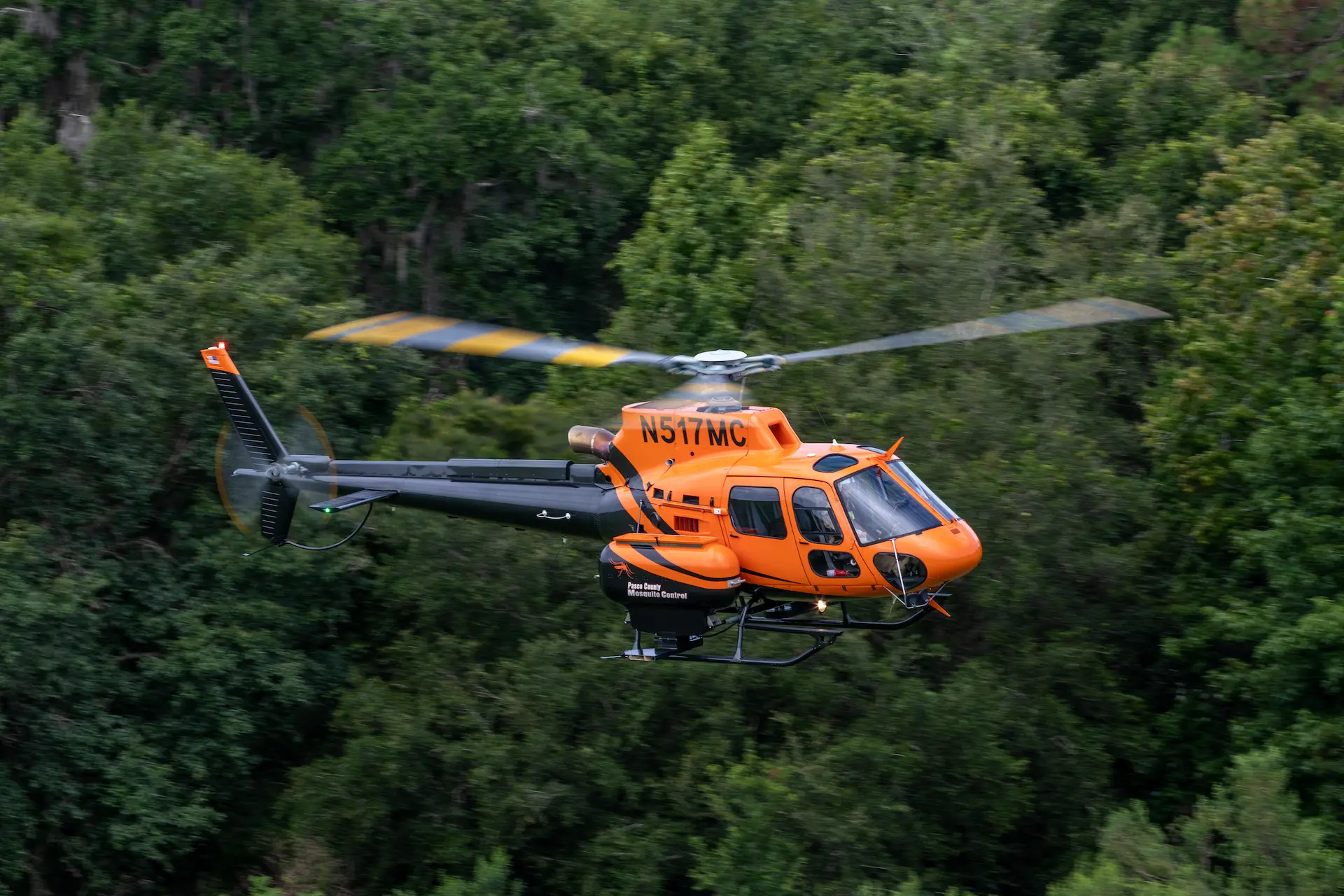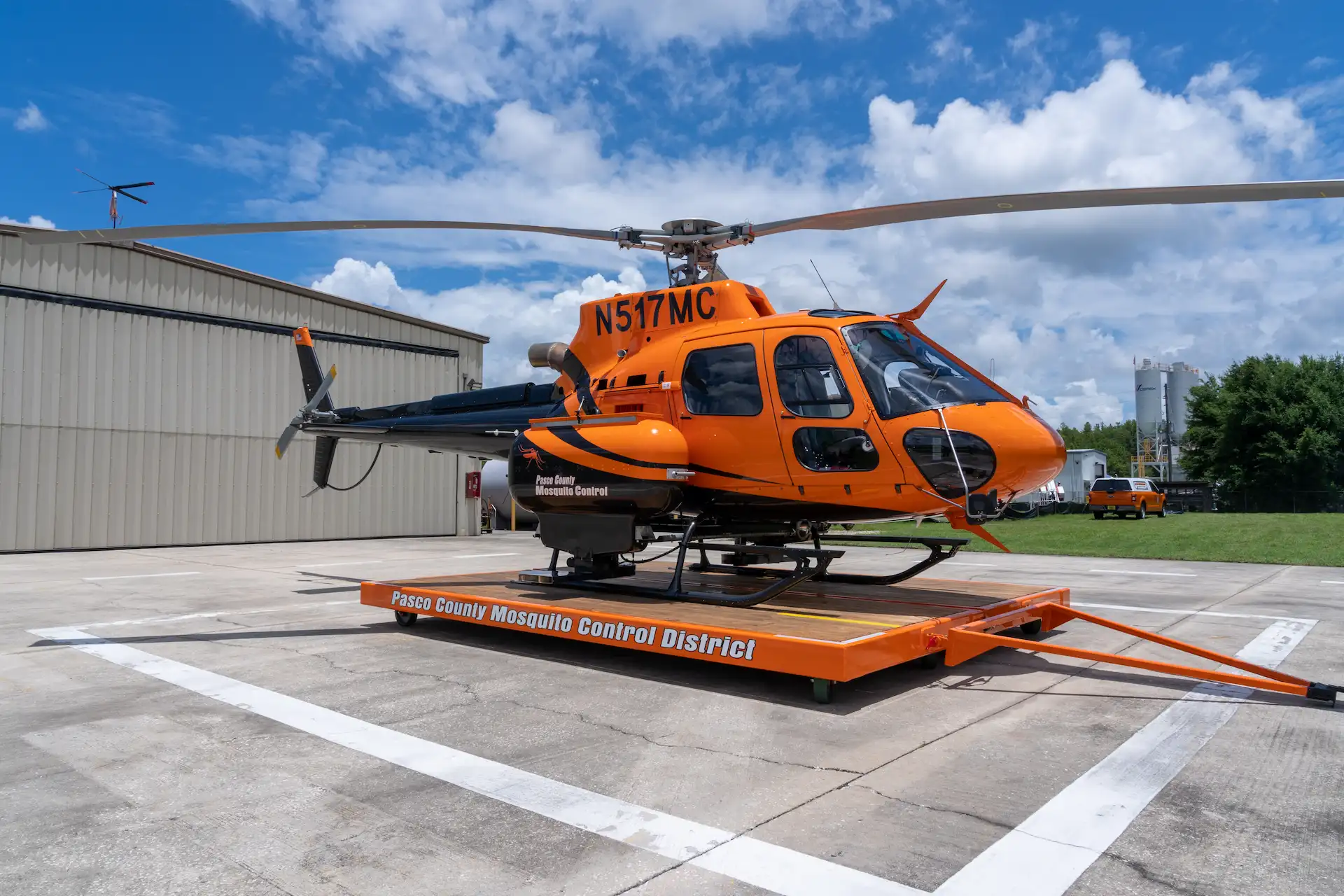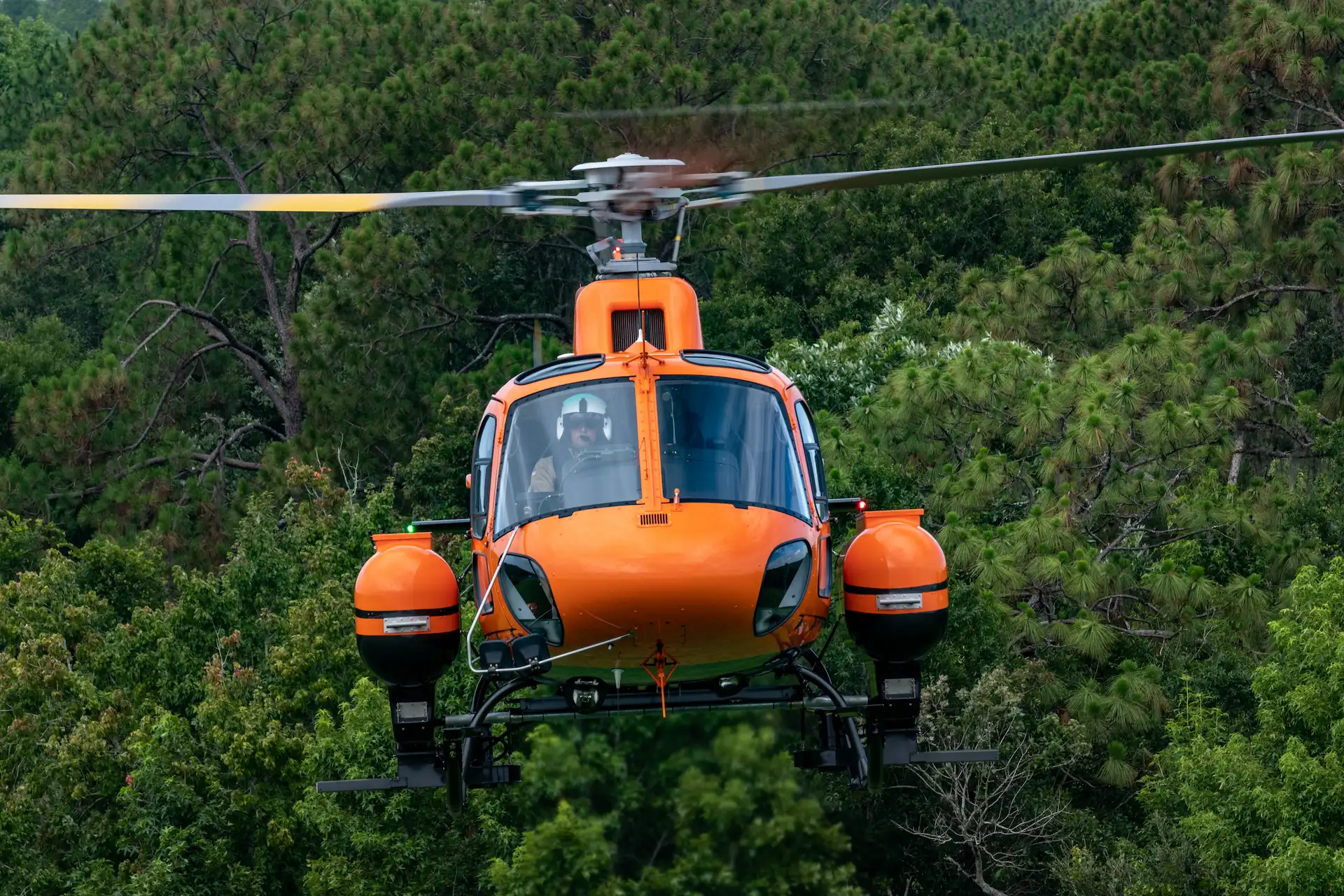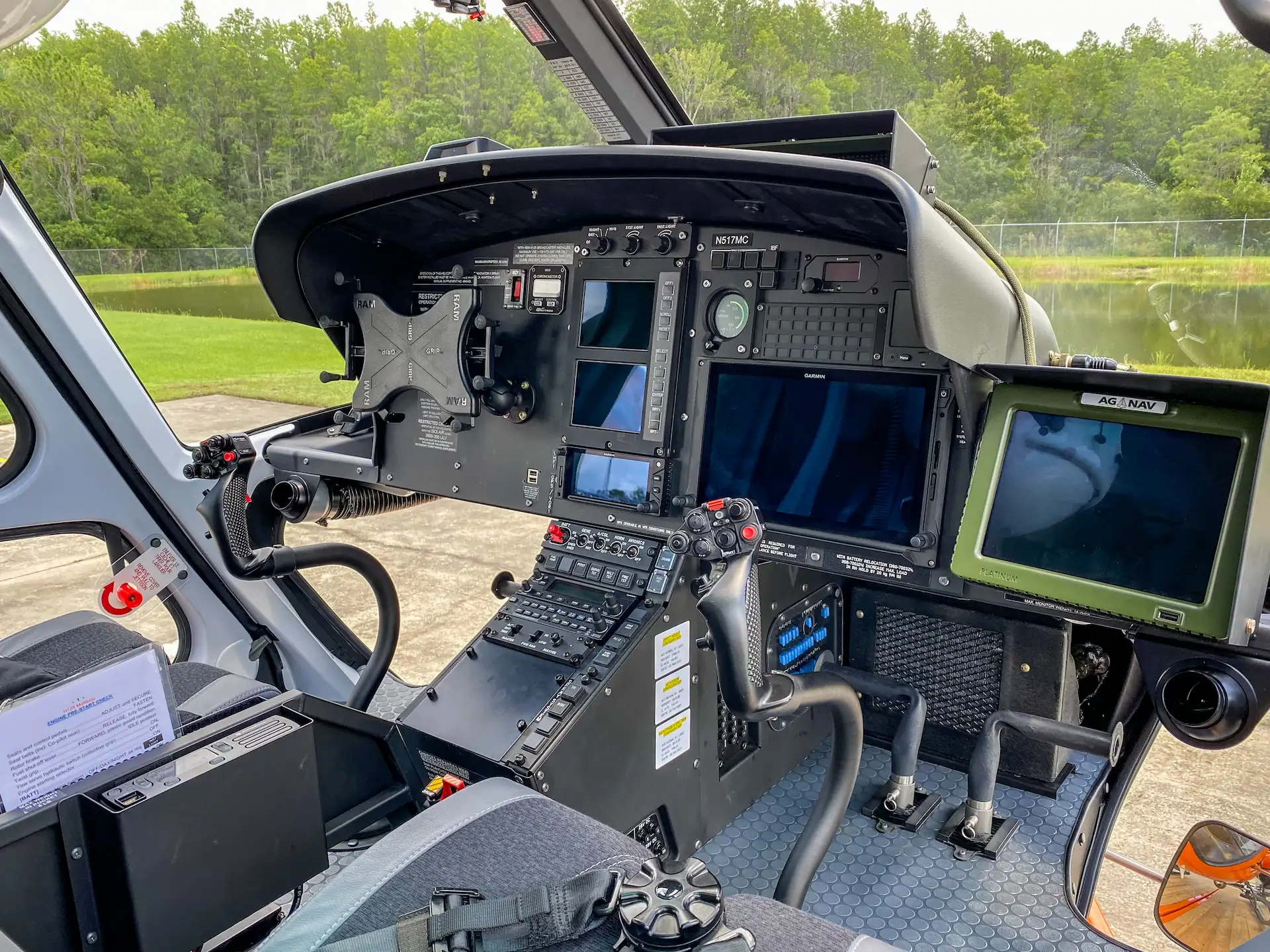Hot, wet conditions in coastal Florida encourage large-scale breeding of mosquitos and the pesky, blood-sucking females not only cause discomfort and nuisance but can also spread a range of diseases. To combat the pests, several counties run mosquito control programs and Jason Jorgensen visited Odessa, Florida to check out Pasco County Mosquito Control District’s evolving operation.
Background
The West Florida Mosquito Control District was first established in 1951, primarily to encourage tourism by reducing mosquito numbers. Aerial control operations were added to its repertoire in the 1980s and the operation was expanded to encompass the whole county about 15 years ago, when it was redesignated as the Pasco County Mosquito Control District (PCMCD). The organization is a stand-alone taxation district funded by taxes, so there is no conflicting demand on its budget.
Around 45 species of mosquito are present in Pasco County but not all significantly impact humans. Adriane Rogers, PCMCD’s Executive Director explained that control efforts focus primarily on twelve distinct species that pose two significant threats. “A key thing to note is that without mosquito control, Florida would be uninhabitable. There’s the nuisance standpoint of mosquitoes just biting and annoying people but understand that mosquitoes are also vectors of diseases, and some species present here can carry some of these viruses. It's a matter of controlling the populations to a low enough level that doesn’t sustain disease transmission. That's a factor that most people don't really know about or think about. They see us applying pesticides to the environment, and don't understand the reasons we do what we're doing, and the public health aspect of the services we provide,” Rogers commented. “We only apply where it's needed. It might be very localized increases in population, so we don't just go out and spray the whole county with pesticide. It's very targeted and scientifically driven. Everything we do has data backing up the need for it, we're doing that surveillance every week and can identify areas where we have higher populations and what species, targeting only those species that are really a problem for people and livestock.”

Although the public perception of PCMC’s work is probably limited to a general awareness of its ground trucks and orange helicopters operating throughout the region, dispensing chemical pesticides to kill mosquitos, the district’s program involves much more than just treatment operations to kill the insects. Surveillance and testing comprising a major part of the program, which runs a large facility housing numerous varied research and testing activities. An education trailer even travels around schools in the district to teach students about the insects and the control district’s operations.
Hunting the Insects
More than seventy traps of various types collect mosquitos from numerous locations to enable insect counts, determine species and test samples of each species for the presence of disease, pesticide resistance and efficacy. Coops of ‘sentinel’ chickens are maintained in specific areas and have blood drawn weekly to test for the presence of arboviruses (viruses transmitted by mosquitoes) including West Nile encephalitis, Eastern Equine encephalitis and St. Louis encephalitis. The district works closely with health authorities to monitor for other exotic diseases such as the Zika virus that can be inadvertently imported, and then spread by mosquitos. The district’s complement of more than thirty cross-trained employees is supplemented by ten to fifteen part-time seasonal staff and the unit is very busy during the summer months controlling both larvae and adult mosquitoes, while during the drier winter months the focus shifts to training, continued education, equipment maintenance, and site access.

Pesticide control operations target either the immature larval stage of the insect’s lifecycle (larviciding) or the adult flying insects (adulticiding), and an occasional ancillary mission is spraying herbicide to kill invasive plants that act as mosquito breeding grounds. The bulk of PCMCD’s work is larviciding, when the larval insects are restricted to the water sources in which they have bred. Most larviciding uses pesticide granules, although some liquid chemicals can also be utilized. Wayne Daniels, 19-year PCMCD veteran and now Director of Air Operations explained, “In this district, the bulk of our larviciding is done with granules, killing the mosquito larvae before they emerge from the water as adults. Once they are adults, it’s all liquid application and that’s when you’ll see our ground trucks out there at night with the foggers, and when we’ll use the spray gear on the aircraft.” Most agricultural spraying tries to minimize drift and get the chemical on the ground, but mosquito control operations require the opposite approach, and the droplet size is miniscule, keeping the chemical airborne and with drift spreading it through the targeted treatment area. Because the droplets must come in contact with the insects’ exoskeleton to work, adulticiding is usually conducted at night, when mosquitos are actively flying around. Although some species are active during the day, it is difficult to spray for the adults as daytime thermal activity makes predicting or controlling spray drift highly problematic, so larviciding is the district’s predominant daytime task. Aerial spraying is not conducted when it is raining, because the hygroscopic (attract and absorb moisture) chemicals are designed to disperse readily in water, so they can gum up and clog the equipment if they get damp too soon.
The fogging trucks treat a swathe about 300ft wide and are highly effective, particularly in built up areas where the droplets can penetrate under and around obstacles close to the ground. To minimize the risk of contamination in the event of a motor accident, the trucks only carry sufficient chemical for that night’s mission and after completing spraying they return to the depot, where they are thoroughly washed down and cleaned. A number of chemicals are used in treatment operations and chemicals are rotated, minimizing the likelihood of the insects developing a resistance or tolerance to any particular pesticide. Individual mosquito species are more susceptible to particular chemicals, so a wide range of pesticides is required to ensure maximum effectiveness of treatments.

Each morning commences with a meeting for entomologists and larvicide crews, who plan out the program for the day and review the previous day’s treatment efforts. A comprehensive map precisely shows treated areas and the chemical used, allowing the planners to compare actual treatments with the planned requirement. It also allows the inspectors to assess the period that those areas will be controlled, eliminating unnecessary inspection and treatment efforts. Daniels elaborated, “We watch the weather closely so we can predict rainfall and the speed and direction of the wind. The tides are important to us too. We have a fairly broad coastline and when we get tides over a certain point, we start to see pocketing in some of the marshland and we start to get saltwater species of mosquitos breeding. When we see our key tide, when it hits about four feet, we start to really concentrate on the coast.” He explained that a main driving event is rainfall, which puts water on the ground, filling up swamps and pastures to create breeding grounds for mosquitos. “We look at radar, online rainfall reporting sites and an extensive internal network of rain gauges to determine where we need to concentrate our inspection efforts. We have an active program going on all the time. Summer months from late June into September are our heaviest months, with lots of rainfall and high temperatures. We can be out there larviciding just an hour after the morning meeting and while we treat the priority sites, the inspectors are out there moving to other options, handling citizen complaints or inspecting known areas where they can make a difference,” he said.
Inspections determine priority areas for control efforts and the planners and larviciding director then establish the spray plans, designating zones for the ground vehicles and polygons to be treated by aircraft, and the specific control agents to be used. The wind speed and direction are crucial factors in planning aerial spray patterns as, although the undisturbed swathe may only be around 1,200ft wide, the fine spray mist can drift up to three miles in wind and still be an effective adulticiding agent.
Aviation
Aircraft are used where very large areas or difficult access make treatment from the ground problematic. Until recently, the PCMCD aerial fleet comprised two Piper Aztec fixed-wings and two MD500C helicopters, but the local airport was sold for redevelopment, so all those aircraft are now being replaced by two Airbus H125 A-Stars bought new in March 2021. The helicopters’ expanded roles will probably increase the annual flight time to about 300hrs per aircraft, up from the 250hrs flown by the 500s. “The airplanes were good for 7,000-8,000 acres per load and a typical night was about 15,000 acres over about a four-hour period,” Daniels related. “The helicopters fly a little slower and don't carry as much chemical, but they can come back to base and don’t need the airport.”

A convertible Isolair dry-application and spraying system is fitted to the new machines to enable them to not only carry out daytime larviciding with granules, but also fulfil the night-time adulticiding liquid spraying missions previously flown by the Aztecs. The 70-gallon Isolair tank is typically only filled with 30 gallons, but that amount will treat about 7,500 acres, depending on the defined swath width and the area being treated. A very short boom assembly extends about 10 to 12 feet on either side of the aircraft and a specialized rotary atomizer ensures precise miniscule droplet size and ultra-low volume chemical consumption. Isolair also made custom polypropylene liners for the district’s tanks, as some of the chemicals do not suit either metal or fiberglass containment. The team has currently got the turnaround time down to just over an hour, to remove the dry system and reinstall the liquid system.
Two service trucks work with the aerial operation, to fuel the aircraft and provide chemical supplies out in the field. While the outgoing MD500s could be turned around in about three minutes with their 480lbs of chemical, the larger 800lb loads of the H125s will extend that time slightly but the new aircraft’s longer range, and higher payload makes it more efficient for treating larger areas. Daniels elaborated, “Growth in our county means we're losing vacant areas to land in to reload, as those areas become more residential. Because we're losing those, we're having to fly further between loads but now we've got enough fuel that we can get out there, spread an entire load and come back, whereas before, we could only take a partial load because of the amount of fuel we had to carry. That allows us to treat a little more acreage.” He advised that virtually all adulticide spraying is conducted at 300ft AGL, minimizing obstacle hazards and aiding spray drift.

Living With the New H125
The decision to go with the H125 as a replacement was aided by the fact that several mosquito control districts and other agencies already operate the type to good effect. “All of the different programs out there are very accessible, and people are more than willing to talk if you have a problem. A lot of programs have had the same issues and it makes life a little easier being able to reach out and talk with people. That networking has been invaluable, and I really enjoy that,” Daniels observed. “Part of the aircraft choice had to do with the spray equipment that was available for that particular aircraft, because that's what we do and there was a little more available for the H125 than there was for the Bell 407 for example. When we were talking to different programs, the H125 was really strong in the market, and we got a really positive response from Airbus. If we had a question, somebody answered, and they were right there with information for us.” Other advantages of the A-Stars are a substantial power increase and the inclusion of air conditioning, something the crews have sorely missed until now in the typically hot and humid Florida conditions. Currency has been a challenge in the mixed fleet of fixed- and rotary-winged aircraft, and the selection of a single type for all aerial application missions has simplified matters and enhanced safety by maximizing type currency for the pilots.
Equipment on the new Airbus machines includes the Spidertracks flight monitoring system, HTAWS (helicopter terrain awareness and warning system), radar altimeter, AG-NAV GPS system for precision spraying and recording, full NVG (night vision goggles) compatibility and the latest Anvis-9 white-phosphorous goggles. While daytime missions will be flown single-pilot, current flying is two-pilot as training and type familiarity continues. Night missions are always flown as a two-pilot crew on NVGs, maximizing situational awareness and therefore safety. Pilot Chris Beaudin started with PCMCD in 2014 and flew the 500s extensively. While he appreciated the unmatched maneuverability and visibility of the smaller machine, he noted it was noisy, old, and not the most comfortable aircraft, so quite fatiguing to fly for long periods. Daniels also like the 500s but cited their age as a problem, commenting, “I can't say enough for the characteristics of the MDs, they were really great machines. We could do things in those that you can't do in a lot of other aircraft. In tight areas they were super maneuverable, and I really like flying them. The problem is that we were flying Charlie models, so there are only a handful left around the world and the people that worked on them are just not in the industry anymore.”
Chief of Maintenance is Jason Phillips, PCMCD’s sole A&P (airframe and powerplant) technician. He outlined how the shift to H125s had affected his side of the operation. “First off, I had to change all my tooling because I had SAE tooling for the American 500s. Now, of course, it's all metric for the European Airbus machines. It's refreshing to have something new, something that's supported because the old 500s proved that as aircraft age, parts availability can be tricky. Airbus support has been really good so far. When you call, they answer the phone and if they don't know, they usually get you the answer pretty quick. It’s been the same on the engine side with Safran, they’ve been really great as well. The maintenance tracking system we use has been beneficial, I would be lost without that, not knowing the inspection intervals and TBO items. Even though the aircraft are brand new, a lot of things still come right from the factory, such as retorques, engine flushes and things of that nature. Not being familiar with all those intervals would have been a nightmare without the tracking system, so it's probably been easier than I expected, but still difficult.”
“The engine seems very maintenance friendly, and you barely touch it until about 800 hours.”

Public Misconception
Daniels added that the crews assist with some of the maintenance tasks, unlike many other programs. “We're right in there with him doing maintenance. He handles all the heavy stuff but for application equipment change outs and that type of thing we're there to help him. Here, because of the size of our program and the way things have developed, everyone wears multiple hats. Part of our job description is to maintain and assist with putting on and taking off all that spray gear. I enjoy doing that and it gives us a closer look at every component, so we get to see what's going on with it, where the wear points are and whatnot.”
As is invariably the case with any helicopter operation, occasional complaints come in from the public. Almost without exception, they are due to a less than complete understanding of the district’s operation, and how it carries it out. Complaints about noise or alleged reckless flying reveal misunderstandings about how aerial application works and how it is conducted.
Another area of public concern is a mistaken belief that the application of chemicals is environmentally unsound. “Common public misconception seems to be that we are putting thousands of gallons of chemicals out,” commented Daniels. “We do put out a lot of chemical because we cover so many acres, but the reality is that the amount of pesticide that we actually put into an area is much, much less than you put out when you use can of fly-spray in your house, and wherever we can we use bio-sensitive products that break down in the environment very quickly.
Everything we do is in accordance with state and federal regulations, and in in the best interest of the public at large.” No doubt, a cessation of mosquito control work would rapidly lead to the region becoming intolerable for human habitation, so it can only be hoped that the public eventually learn and understand what the PCMCD actually does for their comfort and health.
 HOME
HOME


